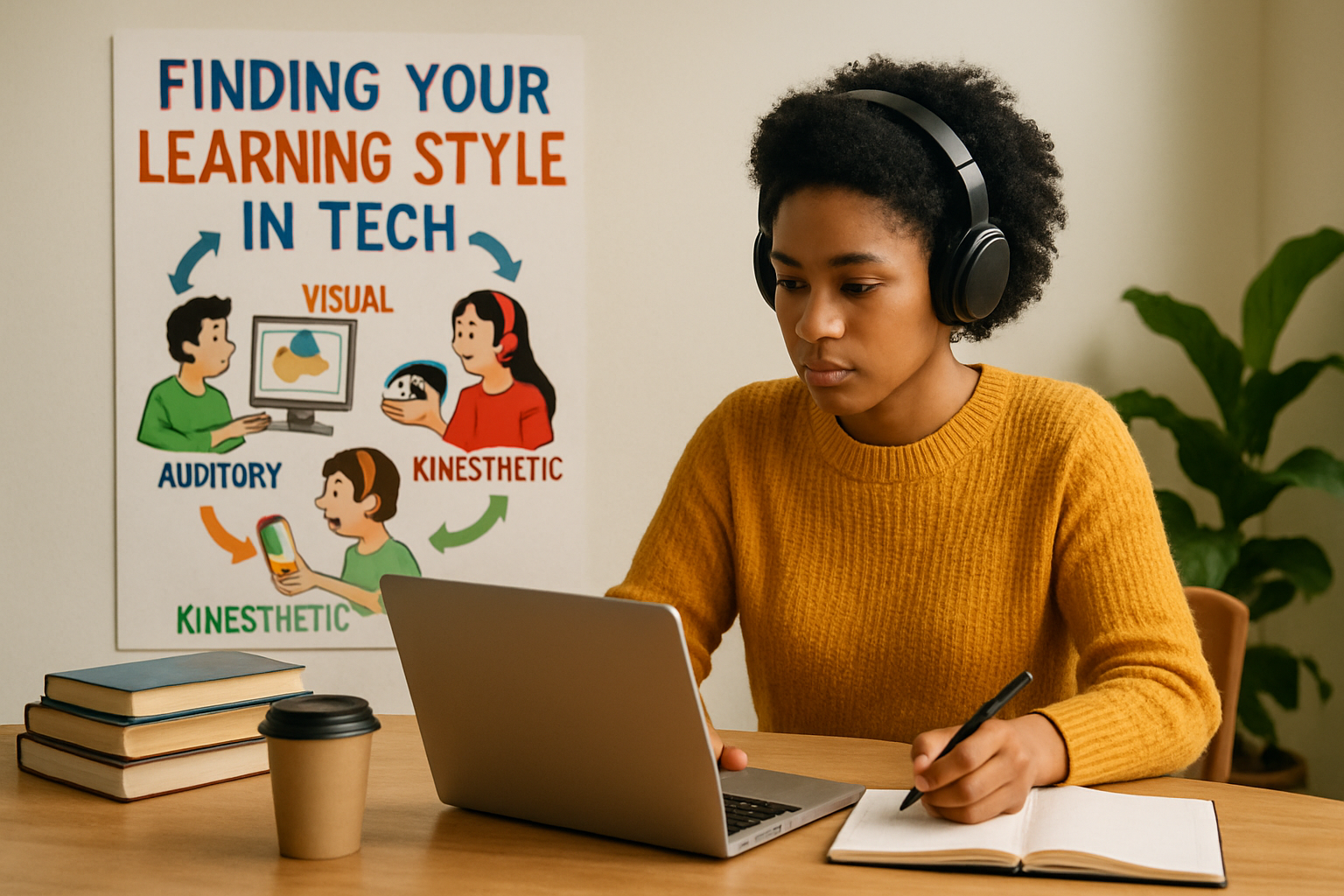
Finding your learning style in tech
Technology is a rapidly evolving space, and learning within it is as much about understanding yourself as it is about understanding code, systems, or frameworks. The journey through tech is not a straight highway; it’s a winding path shaped by personal experience, curiosity, and unique cognitive wiring. Whether you’re a neurotypical learner or someone whose thinking colors outside the lines, discovering your learning style in tech can be transformative. The right approach can make the difference between feeling lost in jargon and thriving as a confident contributor.
Understanding the Diversity of Learning Styles in Tech
Before diving into specific strategies, it’s essential to recognize that learning styles are as varied as the people in technology themselves. Some individuals absorb information best by reading, others by listening, some by doing, and many through a combination of these approaches. In tech, this diversity is magnified by the sheer range of skills required: from hands-on coding to abstract architectural thinking, from solitary debugging to animated team brainstorming.
“There is no one-size-fits-all in tech education. The beauty of technology is that it rewards those who find their unique path.”
For neurodivergent learners—such as those with ADHD, dyslexia, or autism spectrum conditions—the challenge and opportunity are even greater. Traditional, lecture-based approaches might not unlock their full potential. Instead, these learners often thrive when they’re encouraged to explore, play, and build in ways that align with their natural inclinations.
Why Learning Style Matters in Technology
Tech is less about memorizing syntax and more about problem-solving. This means the best way to learn is the way that helps you solve problems, understand concepts, and build confidence. Identifying your learning style isn’t about fitting into a box; it’s about leveraging your strengths and being patient with your challenges. It’s also about recognizing that your ideal style may change over time, or from topic to topic.
Common Learning Styles and How They Map to Tech
Visual Learners
If you find yourself reaching for diagrams, flowcharts, or color-coded notes, you might be a visual learner. In tech, this could mean:
- Sketching system architectures or database schemas on paper or whiteboards.
- Using mind maps to organize complex concepts, such as object-oriented programming principles.
- Leveraging visual tools like Figma for UI/UX design, or using platforms like Lucidchart for workflow visualization.
Actionable Tip: When learning a new framework, try mapping its components visually. Create a flowchart that shows how data moves through a React application, or how microservices interact in a distributed system.
Auditory Learners
For those who best absorb information by listening, tech learning can include:
- Podcasts covering current trends, interviews with engineers, or deep dives into specific languages.
- Attending webinars and tech meetups, where you can hear experts explain concepts in real-time.
- Recording yourself explaining a concept aloud, then replaying it to reinforce your understanding.
Actionable Tip: When stuck on a bug, record a voice note explaining the problem as if teaching a friend. This process often reveals gaps in your understanding and can spark insights.
Kinesthetic (Hands-on) Learners
If you learn best by doing, tech is your playground:
- Build small projects or contribute to open-source to get hands-on practice.
- Experiment with code in sandboxes like Repl.it or Jupyter notebooks.
- Disassemble and reassemble hardware, or create prototypes with Raspberry Pi or Arduino.
Actionable Tip: When learning a new programming language, set a goal to build a specific, simple tool—such as a to-do list app or a weather dashboard. The process of tinkering will cement concepts faster than passive study.
Reading/Writing Learners
If you gravitate toward written documentation, blog posts, or detailed note-taking, you can optimize your learning by:
- Reading official docs and summarizing them in your own words.
- Keeping a learning journal or personal wiki, where you document lessons, errors, and breakthroughs.
- Writing technical blog posts or tutorials to clarify your thinking and contribute to the community.
Actionable Tip: After studying a new API, write a concise guide that explains its use to a beginner. Teaching others is a proven way to solidify your own understanding.
Blended and Adaptive Approaches
Rarely does anyone fit perfectly into a single learning style. Most people benefit from a blend, and the most successful technologists are those who adapt their learning approach based on the problem at hand.
“In tech, adaptability is as important as expertise. The willingness to try new learning methods is a career superpower.”
For example, you might sketch a system design (visual), talk it through with a peer (auditory), prototype a solution (kinesthetic), and document your process (reading/writing). This holistic approach not only deepens understanding but also mirrors the collaborative, fast-evolving nature of tech work.
Women in Tech: Navigating Unique Learning Journeys
Women are driving innovation across the technology landscape, yet many face unique challenges—including access to mentorship, representation, and bias in educational environments. Finding a supportive learning community is critical. Women’s coding bootcamps, online forums, and mentorship initiatives like Women Who Code or Girls Who Code offer both resources and solidarity.
It’s also important for women to recognize and honor their own learning preferences, even if they differ from the dominant culture in a classroom or workplace. The courage to ask questions, seek help, and experiment with new strategies is key to breaking through artificial barriers.
Neurodivergent Learners: Embracing Cognitive Diversity in Tech
Neurodiversity is a strength in technology. People who think differently often notice patterns others miss, approach problems with fresh eyes, and bring creative solutions to the table. Yet, traditional education can under-serve neurodivergent learners, especially those who need more movement, less noise, or alternative communication channels.
For these learners, self-advocacy is essential:
- Seek out asynchronous learning options, like self-paced online courses.
- Build in frequent breaks and movement—coding sprints followed by walks or stretches can boost focus.
- Customize your workspace to minimize distractions—noise-cancelling headphones, fidget tools, or color-coded screens.
- Connect with neurodiversity-friendly tech communities, which foster inclusion and mutual support.
Actionable Tip: If you struggle with reading walls of text, use screen readers or text-to-speech tools. If attention drifts during long videos, speed them up or watch in short bursts, taking notes between segments.
Practical Steps to Discover and Refine Your Learning Style
1. Reflect on Past Experiences
Think about times you learned something complex—tech-related or not. Did you remember a diagram? A conversation? A hands-on project? Which methods made you feel confident? Which frustrated you? This reflection is the first clue to your learning style.
2. Experiment with New Methods
Don’t be afraid to try something outside your comfort zone. If you’ve always read documentation, watch a tutorial video. If you’re a hands-on maker, try summarizing your findings in a blog post. Notice what sticks and what doesn’t.
3. Track Your Progress
Keep a simple journal or log as you learn. Note which resources you used, how you approached a problem, and how well you understood the material. Patterns will emerge, showing you what works best.
4. Ask for Feedback
Share your projects or explanations with peers, mentors, or online communities. Their questions and suggestions can reveal blind spots and inspire new learning strategies.
5. Adapt and Iterate
Your learning style may shift as your skills grow or as you tackle different areas—web development, data science, cloud architecture, and so on. Be willing to adapt, mix, and change your approach. Learning in tech is a journey, not a destination.
Learning Tools and Resources Tailored to Every Style
The good news: the tech world is overflowing with resources tailored to every learning style. A few to consider:
- Visual: YouTube channels like The Net Ninja or Academind, interactive diagrams on Khan Academy, system design visualizations.
- Auditory: Podcasts such as CodeNewbie, DevDiscuss, or Software Engineering Daily; audiobooks on O’Reilly or Audible.
- Kinesthetic: Project-based courses on FreeCodeCamp, Codecademy, or LeetCode for algorithm practice.
- Reading/Writing: Comprehensive docs like MDN Web Docs, technical blogs (CSS-Tricks, Dev.to), and note-taking apps like Notion or Obsidian.
For neurodivergent learners, look for platforms that allow customization—changing fonts, colors, playback speed, or interaction styles. For women in tech, seek out inclusive communities and mentorship programs that reflect your goals and offer a safe space to explore.
Building a Supportive Learning Environment
Whatever your style, a supportive environment makes all the difference. This might mean joining a study group, finding a mentor, or simply setting up a workspace that feels comfortable and inspiring. For many, the greatest breakthroughs come not from solo study, but from collaboration and community.
“Learning in tech is not a solo endeavor. Every question asked, every project shared, every bit of feedback exchanged moves us all forward.”
Over time, you’ll see that your learning style is not a fixed label, but an evolving toolkit. The more you understand about yourself, the more effectively you’ll navigate the ever-changing landscape of technology. In a field defined by curiosity and creativity, your unique approach is not just valid—it’s essential.
As you continue your journey in tech, trust your instincts, embrace experimentation, and remember: the best way to learn is the way that works for you.


